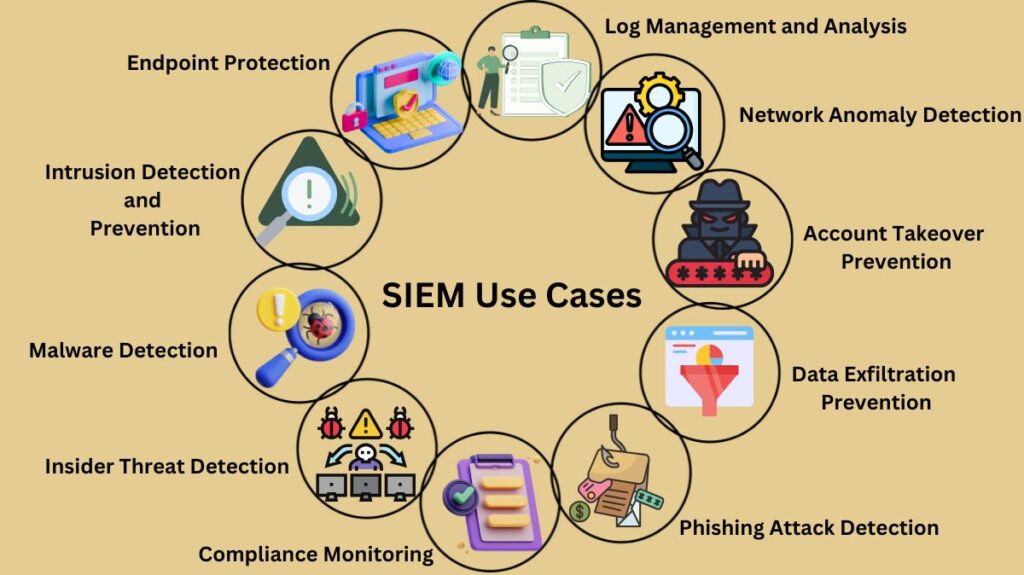SIEM Use Cases

Security Information And Event Management(SIEM) systems are incredibly flexible instruments that assist enterprises in addressing a variety of security issues. The 10 most common use cases for SIEM systems are as follows:
Intrusion Detection and Prevention
SIEM systems are essential for tracking and examining system activity and network traffic in order to detect and identify any intrusion attempts and unauthorized access. The SIEM solution can monitor unusual patterns and actions that might indicate an attack by correlating data from several sources. A SIEM solution may implement automatic responses and notifications as soon as a potential intrusion is detected, such as isolating compromised systems or blocking malicious traffic, to prevent unwanted access and reduce hazards instantly.
Malware Detection
The technology is also used extensively for malware detection and response. The systems use behavior and pattern analysis at endpoints and in the network to identify malware. A SIEM system can keep an eye out for signs of infection, such as odd file modifications, dubious network activity, and other irregularities. After identifying malware, the solution can start containment actions, including device isolation, or antivirus scans to stop the infection’s spread and aid in subsequent cleanup initiatives.
Insider Threat Detection
The issue of identifying threats originating from within the user base is resolved by SIEM systems. The SIEM system accomplishes this by keeping an eye on every user’s activity and seeing trends that could point to insider threats or other policy infractions.
The system may detect abrupt changes in certain patterns related to data access or log-on times, which might be indicators of improper or unintentional employee behavior. Security teams may investigate and lessen any insider threats that could cause harm by using the alarms and information that these SIEM systems can provide.
Compliance Monitoring
Almost all companies are required to adhere to certain industry and regulatory compliance requirements. In this instance, the SIEM systems serve an essential purpose. SIEM systems include the organization’s reporting and logging features to meet regulatory standards including PCI-DSS, GDPR, and HIPAA.
Audits are made easier with comprehensive records of security events and activities created with a SIEM. Organizations may also make sure they can demonstrate their adherence to these regulations and standards, avoiding the danger of incurring fines for noncompliance.
Phishing Attack Detection
SIEM has entered the market to identify and stop phishing assaults, which continue to be a persistent danger. The SIEM platform can fingerprint the majority of phishing traits, such as dubious email content and odd link patterns, by using fingerprinting on user behavior and email traffic. By warning security teams about a potential phishing campaign and enforcing measures to stop fraudulent emails, SIEM systems may drastically lower the likelihood that phishing attacks will be successful and steal critical data.
Data Exfiltration Prevention
It becomes crucial to halt unauthorized data transfers in order to secure sensitive information. To identify and stop possible data exfiltration attempts, the SIEM system must monitor network data traffic. When large amounts of data are delivered to other places, for instance, the SIEM platform analyses patterns and access to data flow that is either odd or not authorized for data movement. If such actions are detected, they can sound the alert and take appropriate action to stop any potential data breach and loss of valuable information.
Account Takeover Prevention
The SIEM systems reduce these possible risks by recording login activity and access to an account that has already been hacked. Additionally, such platforms will identify anomalies such as a high number of unsuccessful login attempts, logins from unidentified locations, or changes to user rights. SIEM solutions have the ability to detect the signs of account takeovers, which can alert security professionals to the potential for breaches and enable remedial action.
Network Anomaly Detection
SIEM systems’ primary purpose is to monitor network traffic for odd patterns, which is an example of network anomaly detection. SIEM solutions track network behavior deviations from the usual and detect threats or assaults, such as network scans or denial-of-service attacks. In order to help the security team respond appropriately and prevent any dangers, these SIEM systems will notify and offer insight on the kind and degree of the anomaly.
Log Management and Analysis
Understanding security events, troubleshooting, and incident analysis all depend on efficient log management. SIEM systems provide an easy-to-read view of the whole organisation by aggregating logs from many sources, including servers, apps, and network devices, for analysis. SIEM solutions facilitate incident investigation and response, root cause analysis, and improved visibility of security problems. Additionally, they facilitate log analysis and aggregation.
Endpoint Protection
SIEM solutions will offer more thorough defense against endpoint-focused attacks when combined with endpoint security technologies. SIEM solutions will be able to detect and respond to threats more effectively if endpoint data is correlated with other network and system event logs. SIEM systems, for example, need to be able to monitor signs of malware infections, odd process behaviors, or unauthorized access on endpoints in a more comprehensive manner. A corresponding improvement in defense against a wide range of threats is guaranteed by the endpoint security paradigm.
